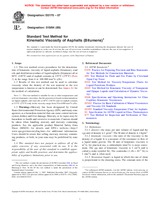Potřebujeme váš souhlas k využití jednotlivých dat, aby se vám mimo jiné mohly ukazovat informace týkající se vašich zájmů. Souhlas udělíte kliknutím na tlačítko „OK“.
ASTM D2170-07
Standard Test Method for Kinematic Viscosity of Asphalts (Bitumens)
Automaticky přeložený název:
Standardní zkušební metoda pro kinematická viskozita asfalty ( Bitumeny )
NORMA vydána dne 1.12.2007
Informace o normě:
Označení normy: ASTM D2170-07
Poznámka: NEPLATNÁ
Datum vydání normy: 1.12.2007
Kód zboží: NS-19506
Počet stran: 10
Přibližná hmotnost: 30 g (0.07 liber)
Země: Americká technická norma
Kategorie: Technické normy ASTM
Anotace textu normy ASTM D2170-07 :
Keywords:
asphalt, capillary, kinematic, viscometer, viscosity, ICS Number Code 91.100.50 (Binders. Sealing materials), 93.080.20 (Road construction materials)
Doplňující informace
| Significance and Use | ||||||||||||||||||
|
The kinematic viscosity characterizes flow behavior. The method is used to determine the consistency of bitumen as one element in establishing the uniformity of shipments or sources of supply. The specifications are usually at temperatures of 60 and 135°C. |
||||||||||||||||||
| 1. Scope | ||||||||||||||||||
|
1.1 This test method covers procedures for the determination of kinematic viscosity of liquid asphalts (bitumens), road oils and distillation residues of liquid asphalts (bitumens) all at 60°C (140°F) and of asphalt cements at 135°C (275°F) (Note 1) in the range from 6 to 100 000 mm2/s (cSt). 1.2 Results of this test method can be used to calculate viscosity when the density of the test material at the test temperature is known or can be determined. See Annex A1 for the method of calculation. Note 1—This test method is suitable for use at other temperatures and at lower kinematic viscosities, but the precision is based on determinations on liquid asphalts and road oils at 60°C (140°F) and on asphalt cements at 135°C (275°F) only in the viscosity range from 30 to 6000 mm2/s (cSt). 1.3 Warning—Mercury has been designated by United States Environmental Protection Agency (EPA) and many state agencies as a hazardous material that can cause central nervous system, kidney and liver damage. Mercury, or its vapor, may be hazardous to health and corrosive to materials. Caution should be taken when handling mercury and mercury containing products. See the applicable product Material Safety Data Sheet (MSDS) for details and EPA’s website—http://www.epa.gov/mercury/faq.htm—for additional information. Users should be aware that selling mercury, mercury containing products, or both, in your state may be prohibited by state law. 1.4 This standard does not purport to address all of the safety concerns, if any, associated with its use. It is the responsibility of the user of this standard to establish appropriate safety and health practices and determine the applicability of regulatory limitations prior to use. |
||||||||||||||||||
| 2. Referenced Documents | ||||||||||||||||||
|




 Cookies
Cookies
